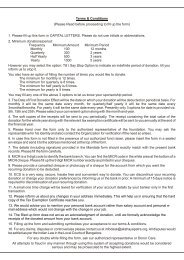The Top 100 NGOs 2013. - Akshaya Patra
The Top 100 NGOs 2013. - Akshaya Patra
The Top 100 NGOs 2013. - Akshaya Patra
You also want an ePaper? Increase the reach of your titles
YUMPU automatically turns print PDFs into web optimized ePapers that Google loves.
workers From <strong>The</strong> un<br />
sTaBilizaTion mission in<br />
haiTi (minusTah) anD Jenkins<br />
anD Penn haiTian relieF<br />
organizaTion remove sTreeT<br />
ruBBle in PorT-au-Prince<br />
©un PhoTo/marco Dormino<br />
FeaTure FeaTure<br />
<strong>The</strong> gloBal Journal + January & FeBruary 2013<br />
<strong>The</strong>gloBalJournal.neT<br />
96 97<br />
coverage gaps were filled. His attempts<br />
ended in exasperation.<br />
When the earthquake struck, longtime<br />
Haiti hands and clear-eyed aid leaders<br />
thus faced a paradox. <strong>The</strong>y knew that<br />
outmoded, uncoordinated assistance<br />
had not only failed to help in the past,<br />
but also helped create the fragility<br />
exposed by the disaster. On the other<br />
hand, there was now an unspeakably<br />
dire emergency, to be followed by<br />
long-term, resource-exhausting<br />
reconstruction. To add final fuel to the<br />
fire, even more <strong>NGOs</strong> – many with no<br />
experience in Haiti whatsoever – were<br />
rushing into the disaster zone, lured<br />
both by a genuine desire to help and a<br />
bonanza of donations pouring in from<br />
shocked observers around the world. In<br />
the US alone, private donations reached<br />
$1.4 billion by year’s end – equating to<br />
approximately $6 per American adult.<br />
Ultimately, more than $3 billion would<br />
be donated to international <strong>NGOs</strong><br />
after the quake, part of a gargantuan<br />
pledged total of $16.3 billion in all.<br />
Coordination would be more crucial,<br />
yet harder to achieve, than ever.<br />
<strong>The</strong> approach chosen after the<br />
catastrophe was to coordinate aid actors<br />
through a system of humanitarian<br />
‘clusters’, in which efforts would be<br />
organized by subject area, such as<br />
housing or sanitation. Representatives<br />
from aid groups of all sizes and<br />
provenances – from Médecins Sans<br />
Frontières to the newest aid-group<br />
leader of all, the movie star Sean Penn<br />
– gathered for regular meetings to share<br />
data, discuss results, and agree on<br />
new strategies. <strong>The</strong> system’s top-level<br />
coordinators were in turn to liaise with<br />
deployed military and other government<br />
agencies in hopes of achieving a<br />
consistent response. Variations on this<br />
basic strategy had been employed after<br />
the 2004 Indian Ocean tsunami and<br />
elsewhere, including at a smaller scale<br />
in Haiti after a series of deadly tropical<br />
storms in 2008.<br />
As I trace in my new book, <strong>The</strong> Big<br />
Truck That Went By: How the World<br />
Came to Save Haiti and Left Behind a<br />
Disaster, the system failed. A critical<br />
moment came at the beginning of<br />
February 2010, toward the end of the<br />
first month after the quake. At that<br />
point, most people in the quake zone<br />
had moved out of the acute crisis stage.





